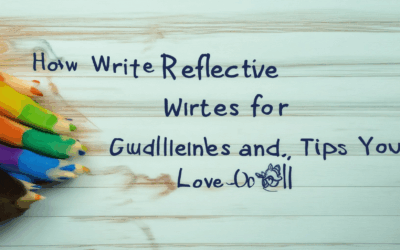Writing reflective essays can be a powerful tool for writers to delve deeper into their thoughts, emotions, and experiences. These essays, often rooted in introspection, allow individuals to explore complex ideas, connect past experiences with present circumstances, and gain clarity on personal growth. For aspiring writers, mastering the craft of reflective writing can transform ideas into meaningful narratives, fostering self-awareness and intellectual growth. This guide will walk you through the essential aspects of crafting reflective essays, from understanding the basics to enhancing your writing skills, ensuring you emerge as a confident and adept writer.

The 5 Rs of Reflective Writing
The 5 Rs of reflective writing are a framework designed to guide writers through the process of reflecting on their experiences, thoughts, and emotions. These Rs help in creating a deeper connection with the material and fostering personal growth. Here’s a breakdown of each component:
- Response : This involves describing your immediate reaction or feelings to an event, thought, or experience. It’s about capturing the raw emotion and details of the moment.
- Relate : Once you’ve responded, you connect your personal experience to a larger theme, concept, or universal idea. This adds meaning and context to your writing.
- Reason : Here, you analyze the situation, look for patterns, and consider possible causes or consequences. It’s about making sense of why things happened the way they did.
- Reconstruct : In this phase, you piece together your thoughts and emotions into a coherent narrative. It’s about organizing your ideas logically and effectively.
- Reflect : Finally, you gain insight or grow from your experience. This is where you draw conclusions, identify lessons learned, and consider how this experience might influence your future actions or perspectives.
By following these steps, reflective writing becomes a powerful tool for self-discovery and personal development. It encourages introspection, critical thinking, and the creation of meaningful content. Whether you’re journaling about a personal achievement or sharing a story with others, incorporating the 5 Rs can enhance the depth and impact of your writing.
Good Sentence Starters for Reflective Essays
A reflective essay invites readers into your thoughts and emotions, offering a glimpse into your internal world. Here are some effective ways to begin your essay:
- Reflecting on… – This opener is versatile and sets a contemplative tone.
- As I reflect on… – Adds a personal touch, making the essay feel more intimate.
- During my time… – Highlights a specific period or journey, showing what you’ve learned.
- Through this journey… – Implies a process of growth or discovery.
- Looking back at… – Ideal for essays focusing on past decisions or experiences.
- I have realized… – Shares a personal insight or realization.
Choose an opener that resonates with your essay’s purpose and style. Whether you prefer a broad statement or a personal pronoun, these options provide a solid foundation for your reflective writing.

Structure of a Reflective Essay
A reflective essay typically follows a structured format to effectively convey personal insights and growth. Below are the key components of its structure:1. **Introduction** – Begin with a hook or engaging statement to capture attention. – Introduce the central theme or topic of reflection. – Provide a clear thesis statement outlining the purpose of the essay. 2. **Body Paragraphs** – Discuss specific experiences, challenges, or moments that contributed to personal growth. – Analyze emotions, thoughts, and reactions to these experiences. – Include anecdotes or examples to illustrate points. – Explore connections between personal experiences and broader themes or concepts. 3. **Reflection and Insight** – Connect personal reflections to universal concepts or life lessons. – Highlight lessons learned and how they influenced behavior or worldview. 4. **Conclusion** – Summarize key insights and the impact of the experiences discussed. – Reflect on how these insights have shaped personal growth or perspective. This structure allows for a deep exploration of self and enables readers to connect with the author’s journey through introspection and analysis.
How to Write a Reflection for Creative Writing
A reflection on creative writing is a thoughtful exercise that allows writers to analyze their work, identify strengths and weaknesses, and gain insight into their creative process. Here’s a structured approach to crafting an effective reflection:
1. Define the Purpose of Your Reflection
Your reflection should serve as a tool for self-assessment and growth. Ask yourself:
- What did you aim to convey in your piece?
- How well did you achieve your goals?
- What aspects of your work do you feel proud of?
- What areas could benefit improvement?
2. Break Down Your Creative Process
Reflect on how you approached your writing project. Consider:
- Insights or inspirations that sparked your ideas.
- Challenges you faced during the writing process.
- Decisions you made (e.g., narrative choices, stylistic choices).
3. Analyze Your Work
Examine your completed piece through the lens of your reflection. Consider:
- Themes, symbols, and motifs present in your work.
- Character development and emotional resonance.
- Structure, pacing, and dialogue effectiveness.
- Cultural or historical context relevance.
4. Explore Emotions and Motivations
Reflect on the emotional journey of your characters and your own emotional investment in the story. Consider:
- How your characters’ emotions drove the plot.
- Your personal feelings or experiences that influenced the writing.
- The impact of setting and atmosphere on your mood.
5. Critique Your Work
Be honest with yourself. Identify areas where you excelled and areas where you can improve. Consider:
- Clarity and coherence of your narrative.
- Consistency in voice and tone.
- Pacing and engagement levels.
- Dialogue and its role in advancing the story.
6. Reflect on Growth
Use your reflection as a roadmap for future improvements. Ask yourself:
- What skills or knowledge do you want to develop?
- What techniques can you apply to future projects?
- What challenges do you hope to overcome?
7. Examples of Reflective Writing Themes
Consider exploring these themes in your reflections:
- The journey of self-discovery.
- Familial relationships and their evolution.
- Social justice issues and their impact on characters.
- Historical events and their legacy.
8. Tips for Effective Reflection
To enhance the depth of your reflection:
- Revisit your work after a break to gain fresh perspective.
- Focus on your emotions and intuition as guides.
- Experiment with different writing styles and perspectives.
- Seek feedback from peers or mentors to gain external insights.
Conclusion
Your reflection is a powerful tool for understanding your creative process and motivating future projects. By thoughtfully analyzing your work, you can identify areas for growth and refine your approach to writing.
How to Begin a Reflective Essay
A reflective essay is a personal and introspective piece of writing where you explore your thoughts, feelings, and experiences. To craft a compelling introduction, consider the following steps:
Purpose and Focus
Clearly define the purpose of your essay. Are you reflecting on a personal growth experience, a challenging situation, or a lesson learned? Your purpose will guide the rest of your essay and establish its tone.
State Your Topic
Announce your topic early in the introduction. Whether it’s a specific event, emotion, or concept, being direct helps readers understand the focus of your reflection.
Thesis Statement
Include a thesis statement that encapsulates your central idea. For example, if you’re reflecting on a transformative experience, your thesis might be: “This experience has led me to realize my true passion for helping others.”
Example: Personal Growth Reflection
If your topic is personal growth, you might write: “I have decided to reflect on my journey of self-discovery over the past year, which has been both challenging and enlightening. Through this process, I hope to gain deeper understanding of myself and identify areas for growth.”
Engage Readers with Emotion
Use descriptive language to evoke emotions and draw readers in. Share a vivid memory or feeling that sets the stage for your reflection.
Link to Resources
For tips on refining your reflective writing skills, visit [Silken Drum](https://silkendrum.com/) or explore similar guides on platforms like [The Writer’s Hub](https://www.thewritershub.com/).By following these steps, you’ll create a thought-provoking introduction that hooks readers and sets the stage for a meaningful reflection.
Reflective Writing Example
Reflective writing is a process where individuals write down their thoughts, feelings, and experiences to gain insight and understanding. Here’s a simple example:
I was supposed to deliver a presentation at work, but my nerves got the better of me. As I stood in front of my colleagues, I could feel my heart racing, and my voice trembled slightly. I had prepared thoroughly, but when I started speaking, I realized I wasn’t connecting with the audience as I hoped. My mind went blank, and I could feel my confidence fading.
After the presentation, I sat down feeling deflated. I reflected on what had gone wrong. I recognized that I hadn’t practiced enough in front of others, and I hadn’t anticipated how intimidating the situation would be. I decided to talk to my supervisor about it, and together we identified areas where I needed to improve, like practicing more in front of a mirror or doing mock presentations.
Reflecting on this experience taught me the importance of preparation and self-awareness. It also showed me that it’s okay to face challenges and that growing from them is a natural part of learning.
Conclusion
Reflective writing allows individuals to explore their emotions and actions, providing valuable insights for personal growth and improvement.




0 Comments